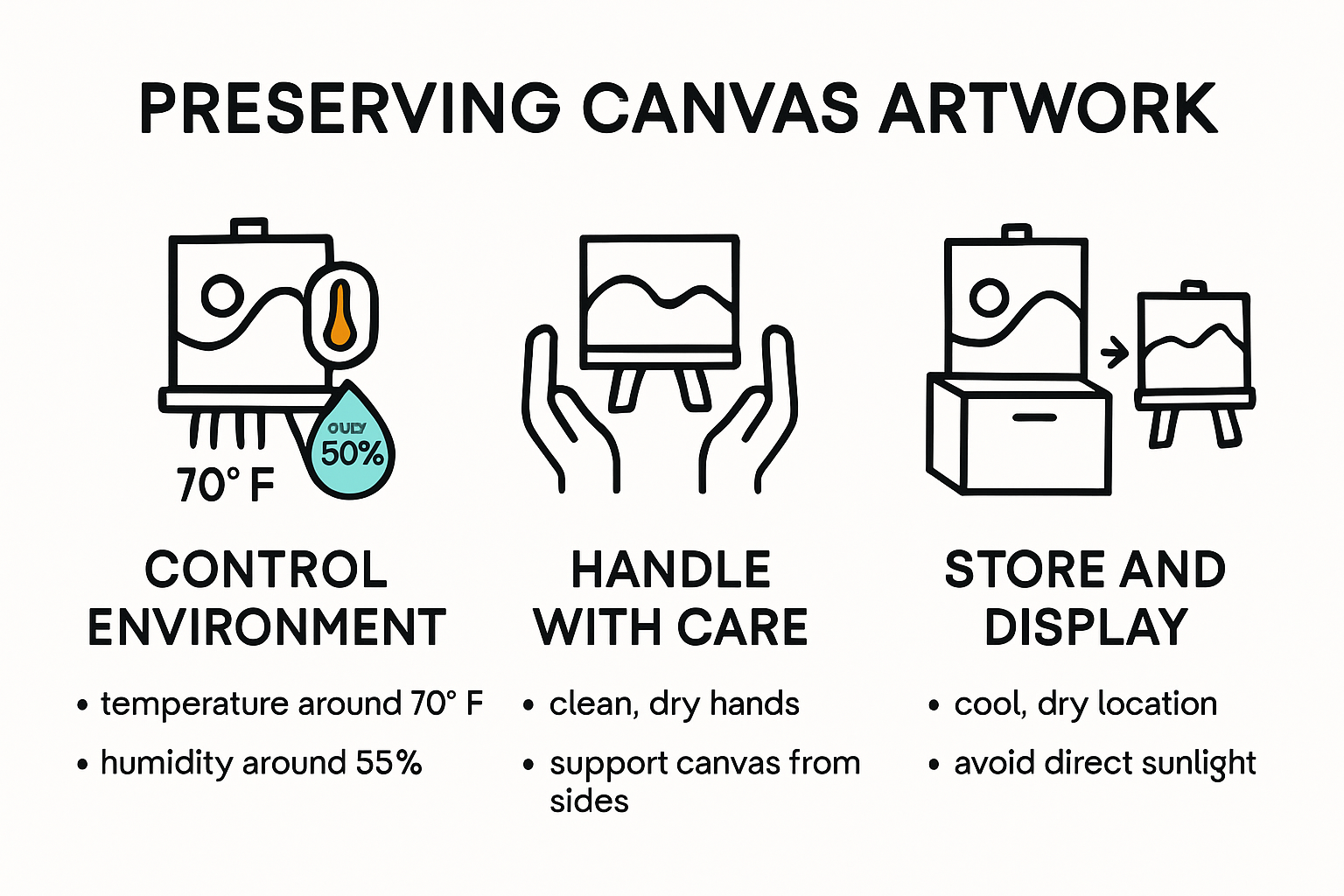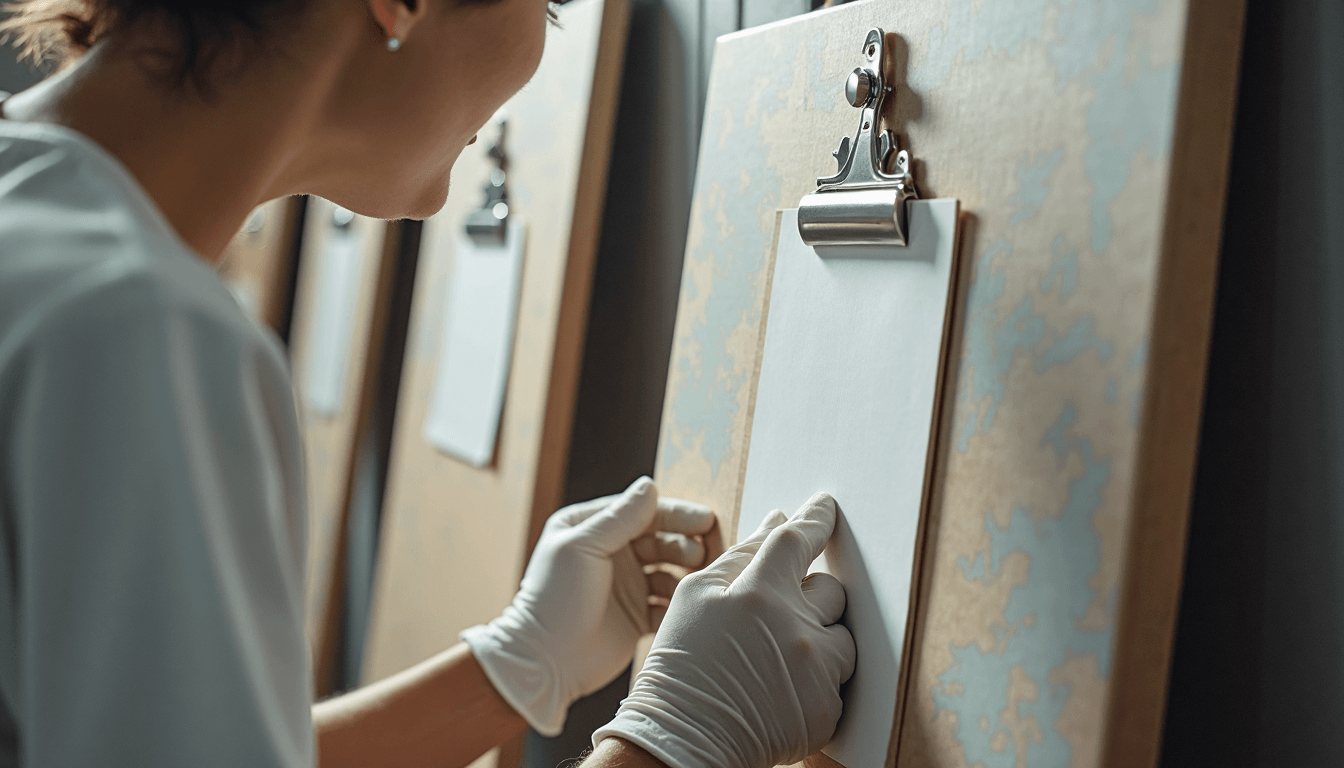
Preserving Canvas Artwork: Best Tips for Art Lovers 2025

Everyone loves the look of original canvas artwork hanging on their walls, and collectors know that properly cared-for canvases can retain value for decades. Here is something that might surprise you. Even small changes in humidity can cause canvas to warp or paint to crack, with recommended safe humidity levels between 40 and 60 percent. Most people think careful dusting and good framing is enough to preserve art, but it actually takes much more precision and science than you might imagine.
Table of Contents
- Why Preserving Canvas Artwork Matters
- Essential Care And Storage Practices
- Framing And Display Tips For Longevity
- Handling And Cleaning Modern Canvas Art
Quick Summary
| Takeaway | Explanation |
|---|---|
| Maintain Stable Environmental Conditions | Keep relative humidity between 40%-60% and temperatures between 65°F-75°F to prevent mold growth and structural damage to canvas artworks. |
| Use Proper Handling Techniques | Always handle canvas artworks with clean, lint-free gloves and support the entire frame to minimize the risk of damage. |
| Implement Light Protection Strategies | Use UV-filtering glass for framing and avoid direct sunlight to prevent fading and degradation of the artwork. |
| Invest in Professional Storage Solutions | Consider climate-controlled storage options to protect artworks from temperature and humidity fluctuations. |
| Consult Professionals for Cleaning | For any significant cleaning, always consult a professional conservator to prevent irreversible damage to canvas artworks. |

Why Preserving Canvas Artwork Matters
Preserving canvas artwork is not merely a suggestion but a critical practice for art enthusiasts, collectors, and cultural preservationists. The intricate process of maintaining canvas pieces goes far beyond simple aesthetic considerations, encompassing historical, financial, and emotional dimensions that make conservation a profound responsibility.
The Hidden Vulnerability of Canvas Art
Canvas artwork represents a delicate intersection of artistic expression and material fragility. According to conservation experts at the Canadian Conservation Institute, canvas paintings are extraordinarily susceptible to environmental changes. Humidity fluctuations can cause significant structural damage, potentially leading to canvas warping, paint cracking, and even mold growth. These environmental threats are not hypothetical risks but real challenges that can permanently compromise an artwork’s integrity.
Temperature and humidity are particularly critical factors. Dramatic shifts can cause canvas fibers to expand and contract, creating microscopic stress points that gradually weaken the artwork’s structure. Professional conservators recommend maintaining consistent environmental conditions to prevent these gradual but irreversible degradation processes.
Cultural and Historical Preservation
Research from cultural preservation specialists highlights that preserving canvas artwork extends beyond individual ownership. Each artwork represents a slice of cultural heritage, capturing moments, emotions, and historical contexts that future generations can study and appreciate. When properly maintained, canvas pieces become more than decorative objects they transform into historical documents that communicate artistic narratives across time.
The financial implications of preservation are equally significant. Well-maintained artworks retain and often increase in value, making conservation a strategic investment. Collectors who understand preventive conservation techniques can protect their artistic assets from depreciation caused by environmental damage.
Strategic Conservation Approaches
Experts recommend implementing systematic preservation strategies that address multiple potential degradation sources. These strategies include controlling light exposure, managing humidity levels, and creating stable storage environments. Professional conservationists suggest using archival-quality materials, avoiding direct sunlight, and maintaining consistent temperature ranges between 65-70 degrees Fahrenheit.
For art lovers interested in detailed preservation techniques, our comprehensive guide on protecting wall art offers advanced insights into maintaining your canvas collection’s pristine condition. Understanding these nuanced preservation methods transforms casual art appreciation into a responsible, informed approach to cultural stewardship.
Ultimately, preserving canvas artwork is an act of respect. It honors the artist’s original vision, protects cultural narratives, and ensures that creative expressions continue inspiring and educating viewers for generations to come.
Essential Care and Storage Practices

Preserving canvas artwork requires a strategic approach that goes beyond basic handling. Professional conservators emphasize the importance of creating an environment that protects delicate artwork from potential damage, focusing on precise environmental controls and specialized storage techniques.
Creating the Ideal Storage Environment
According to the Canadian Conservation Institute, maintaining a stable environment is crucial for canvas artwork preservation. The recommended conditions include keeping relative humidity between 40% and 60%, with temperatures consistently maintained between 18°C and 24°C (65°F to 75°F). These precise parameters help prevent significant threats like mold growth, canvas warping, and paint cracking.
Additionally, protecting artwork from direct light exposure is critical. Ultraviolet rays can cause irreversible fading and material degradation. Conservation experts recommend using specialized museum-grade UV filtering glass or placing artwork away from direct sunlight. Indirect, controlled lighting ensures your canvas pieces remain vibrant and structurally intact.
Proper Handling and Physical Protection
Research from preservation specialists reveals that physical handling poses significant risks to canvas artwork. Always handle paintings with clean, lint-free cotton gloves to prevent oil transfer from skin. When moving artwork, support the entire frame or stretcher, avoiding contact with the painted surface.
Conservationists at the Canadian Conservation Institute strongly recommend storing paintings vertically rather than stacking them horizontally. This approach prevents unnecessary pressure on the paint surface and reduces risks of warping or sagging. For added protection, attach a rigid backing board to the reverse of canvas paintings, which helps stabilize the artwork and minimize vibrations during transportation.
Advanced Storage Techniques
For serious art collectors, investing in professional storage solutions is paramount. Climate-controlled storage units designed specifically for artwork provide optimal preservation conditions. These specialized spaces maintain consistent temperature and humidity, protecting your canvas pieces from environmental fluctuations.
For more detailed guidance on protecting your art collection, our comprehensive storage guide offers in-depth strategies tailored for art enthusiasts. Implementing these professional-grade conservation techniques transforms casual art ownership into responsible cultural preservation.
Remember that each canvas artwork is a unique combination of artistic expression and delicate materials. Thoughtful, proactive care ensures these creative treasures remain vibrant, structurally sound, and capable of inspiring future generations of art lovers.
To help you better understand the best care and storage practices for canvas artwork, here is a summary table of environmental and handling recommendations:
| Care Aspect | Recommended Practice | Purpose/Benefit |
|---|---|---|
| Humidity | Maintain 40%-60% relative humidity | Prevents warping, cracking, and mold |
| Temperature | Keep temperature 65°F-75°F (18°C-24°C) | Limits stress on canvas fibers |
| Light Exposure | Use UV-filtering glass, avoid direct sunlight | Prevents fading and degradation |
| Handling | Wear clean, lint-free gloves; support entire frame | Minimizes transfer of oils and reduces damage risk |
| Storage Orientation | Store paintings vertically, not stacked horizontally | Reduces pressure and risk of warping |
| Backing | Use rigid, archival-quality backing boards | Stabilizes artwork and prevents vibrations |
| Storage Solution | Use climate-controlled storage for valuable collections | Maintains stable conditions and prevents damage |
Framing and Display Tips for Longevity
Framing and displaying canvas artwork is an art form in itself, requiring precision, knowledge, and a deep understanding of conservation principles. The right framing approach can significantly extend the lifespan of your cherished artwork while enhancing its visual appeal and structural integrity.
Choosing the Right Framing Techniques
According to conservation experts at the Canadian Conservation Institute, proper framing goes far beyond aesthetic considerations. The structural support provided by a frame is critical to protecting canvas artwork from environmental stressors. Professional conservators recommend using frames that are strong enough to support the painting’s weight while allowing for slight expansion and contraction caused by temperature and humidity changes.
Crucial framing considerations include avoiding direct contact between the artwork and framing materials. Metal mending plates should be attached only to the frame, never directly to the stretcher or strainer. This approach prevents potential damage and allows the canvas to move naturally with environmental shifts. For added protection, attach a rigid backing board made of archival-quality materials like corrugated plastic, which helps stabilize the artwork and minimize potential vibrations during handling.
Light Protection and Display Strategies
Preservation specialists emphasize the critical importance of light management. Direct sunlight and intense artificial lighting can cause irreversible damage to canvas artwork. When using glazing (glass or acrylic), implement a spacer to ensure the protective covering does not directly touch the paint surface. This small but significant detail prevents potential adhesion and damage to the artwork.
For optimal preservation, consider the following display strategies:
- Rotate artwork periodically to minimize continuous light exposure
- Use UV-filtering glass or acrylic for additional protection
- Maintain consistent indirect lighting
- Avoid hanging artwork near heat sources or air conditioning vents
Advanced Display Considerations
Museum-grade conservation techniques offer valuable insights for art enthusiasts. Professional conservators recommend creating a microclimate around valuable artworks. This involves carefully controlling humidity, temperature, and light exposure to minimize potential degradation.
For art lovers seeking comprehensive guidance on displaying their collection, our detailed preservation guide provides expert insights into creating the perfect environment for your cherished pieces. Understanding these nuanced display techniques transforms simple art ownership into responsible cultural preservation.
Ultimately, framing and displaying canvas artwork is a delicate balance between aesthetic appreciation and scientific preservation. By implementing these professional strategies, you protect not just a piece of art, but a fragment of creative expression that can inspire and delight for generations to come. Each carefully chosen frame, each thoughtfully managed display space becomes a testament to the art of preservation.
The following table summarizes key framing and display recommendations for increasing artwork longevity:
| Framing/Display Element | Recommendation | Preservation Reason |
|---|---|---|
| Frame Strength | Use frames strong enough for the size/weight of the painting | Prevents deformation and supports artwork |
| Metal Mending Plates | Attach plates to frame, not stretcher | Allows natural movement and prevents damage |
| Backing Board | Use rigid, archival-quality materials (e.g., corrugated plastic) | Stabilizes and protects from vibrations |
| Glazing (Glass/Acrylic) | Use UV-filtering material with spacers | Prevents fading and paint contact |
| Display Location | Avoid direct sunlight, heat sources, and air conditioning vents | Prevents light and temperature damage |
| Light Exposure | Rotate artwork; keep lighting indirect and consistent | Minimizes cumulative exposure/fading |
Handling and Cleaning Modern Canvas Art
Handling and cleaning modern canvas artwork requires extraordinary precision and care. One misguided touch or inappropriate cleaning technique can potentially cause irreversible damage to delicate artistic surfaces, transforming a moment of maintenance into a preservation nightmare.
Professional Handling Protocols
According to conservation experts at the Canadian Conservation Institute, proper artwork handling is a meticulous process that demands specialized knowledge. Always wear clean, well-fitting cotton gloves when touching canvas artwork to prevent transferring natural skin oils, dirt, and potential contaminants. These gloves create a protective barrier between human hands and the delicate artwork surface.
When moving canvas pieces, support the entire frame or stretcher, never touching the painted surface directly. Lift paintings from both sides with gentle, even pressure, keeping the artwork vertical to minimize potential stress on the canvas. Careful movement is crucial to preventing accidental tears, scratches, or structural damage.
Dust Removal and Maintenance
Preservation specialists from museum conservation institutions recommend extremely cautious dust removal techniques. Use only soft, natural-hair artist brushes specifically designed for delicate surfaces. When dusting, position the painting at a slight forward angle, allowing dust to fall away naturally rather than settling back onto the artwork.
Critical dust removal guidelines include:
- Use only soft, natural-hair brushes with gentle, light strokes
- Work from top to bottom of the painting
- Avoid applying any pressure while brushing
- Never use feather dusters, dry cloths, or mechanical cleaning tools
Professional Cleaning Considerations
Experts strongly caution against amateur cleaning attempts. Water-based solutions, household cleaners, and improvised cleaning methods can cause catastrophic damage to canvas artwork. Paint layers can weaken, colors might fade, and structural integrity could be permanently compromised.
For comprehensive guidance on maintaining your art collection, our specialized preservation guide offers professional insights. When significant cleaning or restoration is required, always consult a professional art conservator who can assess and treat your artwork with specialized techniques.
Remember that modern canvas art represents more than a decorative object it embodies an artist’s vision, emotional expression, and cultural narrative. Treating these pieces with reverence, understanding, and professional care ensures their beauty and significance remain intact for future generations to appreciate and enjoy.
Frequently Asked Questions
What are the ideal humidity and temperature levels for preserving canvas artwork?
Maintaining relative humidity between 40% and 60% and temperatures between 65°F and 75°F is crucial for preventing mold growth and structural damage to canvas artworks.
How should I handle canvas artwork to avoid damage?
Always handle canvas artwork with clean, lint-free gloves and support the entire frame. Avoid touching the painted surface to minimize the risk of transferring oils or causing damage.
What is the best way to protect canvas artwork from light exposure?
Use UV-filtering glass when framing and avoid displaying artwork in direct sunlight. Indirect, controlled lighting is recommended to prevent fading and degradation.
How often should I dust my canvas artwork, and how should I do it?
Dust your canvas artwork regularly using a soft, natural-hair artist brush. Work from top to bottom and avoid applying pressure to prevent damage to the surface.
Elevate Your Art Collection With Lasting Beauty
Do you worry about the long-term condition of your canvas artwork or feel overwhelmed by the responsibility of proper care? The article highlights how even minor changes in humidity or sunlight can cause warping, fading, and irreversible damage to your most-loved pieces. Preserving art is about more than dusting or framing—it is about protecting memories and investment. You deserve artwork that looks vibrant year after year, without the stress of constant upkeep.

Make your next art purchase worry-free by choosing high-quality materials and timeless designs. Every piece from Marta Ellie’s Collection is crafted with both beauty and durability in mind, so your artwork stands the test of time. Ready to give your walls something truly special? Explore our exclusive canvas prints and transform your home with lasting elegance today. Find your next favorite piece and enjoy the confidence of art that is made to last. Visit Marta Ellie’s website and start your collection now.
Recommended
- Caring for Canvas Art: Expert Tips for Wall Decor 2025 – Exclusive Canvas Art
- How to Store Art Safely: Protect Your Wall Art and Canvas in 2025 – Exclusive Canvas Art
- How to Store Canvas: Protect Modern Art & Luxury Prints 2025 – Exclusive Canvas Art
- How to Display Canvas Prints: Fresh Ideas for Modern Walls 2025 – Exclusive Canvas Art
- Storytelling Through Art: Wall Decor Ideas for 2025 Collectors – Exclusive Canvas Art
- How to Choose Art for Living Room Walls: 2025 Guide – Exclusive Canvas Art